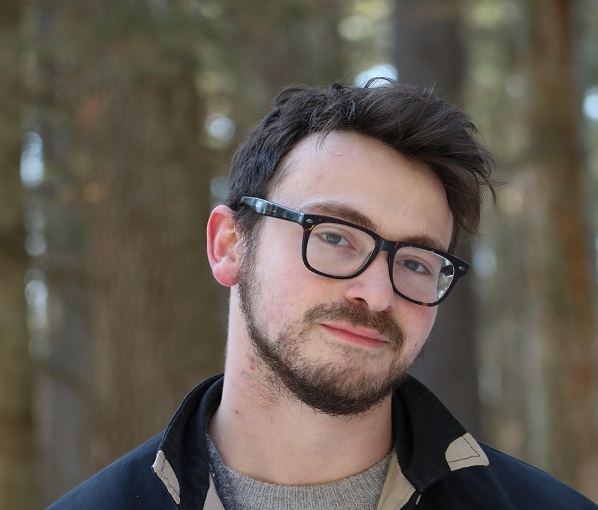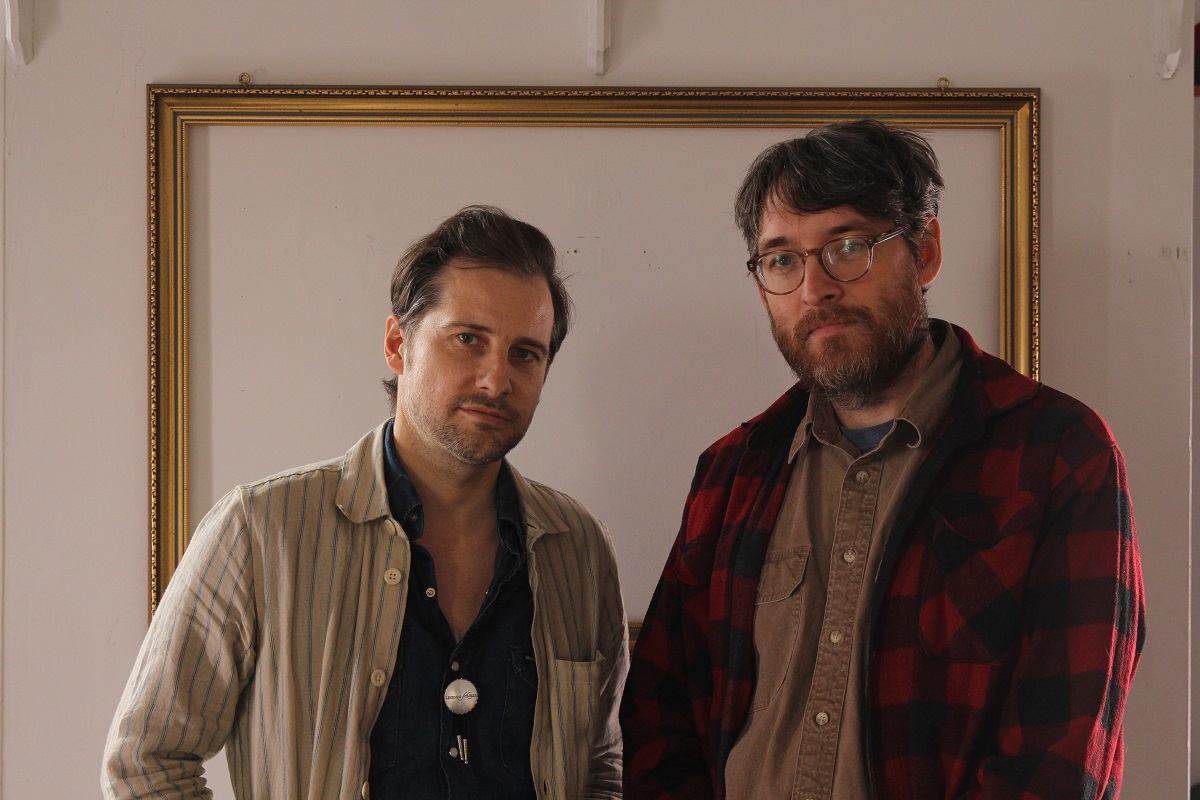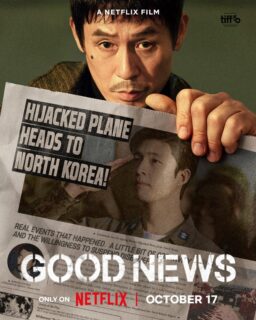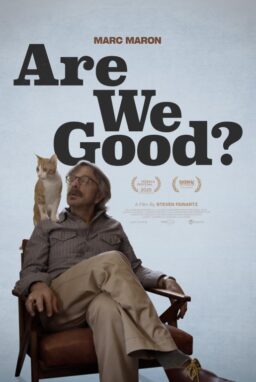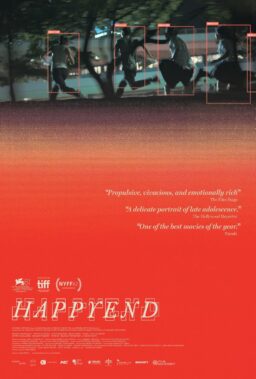A dazzlingly imaginative new film by Kentucker Audley and Albert Birney, “Strawberry Mansion” (in select theaters now) is set in the year 2035 and stars Audley as James Preble, a “dream auditor” for the U.S. government. In its near-future surveillance state, dreams are taxed and recorded; they’ve also become vulnerable to advertisers, who’ve cluttered our minds with commercials for spider sprays and fried-chicken-and-gravy shakes.
Sent to a remote house in the countryside to assess the unpaid taxes of an elderly widow named Arabella (Penny Fuller), who never upgraded to the automated system and hasn’t filed in years, Preble discovers that she has instead stored her dreams on thousands of VHS tapes littered around the living room. Defiantly analog in a digital society, ‘Bella’ has also managed to shield her dreams from product placement through the use of a jerry-rigged helmet. When Preble tries this device out for himself, the experience threatens to break his brain or set him free, especially once he falls for visions of a younger Bella (Grace Glowicki) he meets in her subconscious.
As “Strawberry Mansion” unspools, corporate forces intrude upon its sweet reveries, which respond with flights of fancy so sustained they swirl dreaming and reality together into a vivid, surreal other-realm. Audley and Birney wrote and edited “Strawberry Mansion” in addition to directing, and their depiction of dream logic as a kind of life-affirming astral escapism is emotional, intricate, and aesthetically inspired, enough so as to suggest a certain mastery over all those areas.
The film also makes clear that what most unlocks a childlike exuberance in its directors is the mixing and matching of various cinematic forms and techniques. Shot digitally then transferred to 16mm, making use of stop-motion and handmade miniatures, and filled with retro flourishes that deepen its sense of timeless romance, “Strawberry Mansion” at every turn unmoors itself from reality in favor of big-picture possibility.
With whirring, whiz-bang ingenuity, Audley and Birney set themselves free to play, in doing so realizing the film’s lo-fi, low-budget nature as an extension of its premise. In other words, “Strawberry Mansion” is a powerfully imaginative work about works of powerful imagination. As it hits select theaters today ahead of a VOD rollout next week, Audley and Birney spoke about dream logic, targeted ads, and “Apocalypse Now.”
I know you’ve worked together before, but I’d love to hear about how you both met, and where “Strawberry Mansion” started for each of you.
ALBERT BIRNEY: We first met at a film festival in Baltimore, where I am based out of: the Maryland Film Festival, in 2011. We were both there with other projects. We kept in touch over email for a couple of years and then found ourselves working on an independent film called “Funny Bunny,” in 2013. Kentucker was in it, and I was on the crew; we just got to know each other over the course of a month, working on that movie. At the time, I was dressing up as a gorilla for six-second videos on Vine. And Kentucker saw the potential there; I had amassed all of these people watching these videos, and he was like, “Hey, would you want to collaborate and turn this into a movie?” I said, “Yeah, it’d be great.”
And we did that. We made a movie, “Sylvio,” in 2017. “Strawberry Mansion” was just an idea that I’d had for years. Going back, at this point, it was 15 years ago. And I’d had a very early rough draft of the script; I would start and stop working on it over the years. I had originally approached Kentucker even before “Sylvio” about acting in it, before it was anything. But after “Sylvio,” I was like “Hey, what if we dusted this off and tried to enter this world, to make this trippy dream movie together?” And here we are.
KENTUCKER AUDLEY: I came into this film with a background in filmmaking that was more in a naturalistic, almost documentary style—and very subdued, visually. When Albert came to me with this project, it was initially as an actor. When we became friends over the course of a couple of years, it started to become a possibility that we would make it together. But generally, I was just excited by a more imaginative visual sense that I had steered clear of in my previous filmmaking work.
I was interested in exploring and trying to create a more memorable cinematic language than two people on a couch sitting and talking about their relationship, which is what I had been doing — which I thought was interesting and still do. But when you’re making a movie about dreams, there are unlimited possibilities with the visuals; making any movie, there are unlimited possibilities, but this was a good way to dip my toe into the waters of fantasy image creation.
Setting it in a dream and trying to nail dream logic, you allow the viewer to just be going along on this journey where anything could happen. It could shift gears at any moment. As a filmmaker, that’s a really exciting place to start from. It can become difficult with how you bring a viewer along through that kind of freedom, because it can get a little loosey-goosey and tangential.

To dive further into that dream logic, I felt that “Strawberry Mansion” nailed the actual sensation of dreaming, in all its digressions and dissolves, more than most films I’ve seen on the subject. How did you approach that element of the story?
AB: We weren’t really doing any scientific research. It was more about how our own dreams made us feel in our lives. What does it feel like to be 12 years old, to have a dream where you fall in love, and to then wake up and find that person is gone? What does that feel like? We were trying to honor the emotional feeling of dreams, the way that they can change and implode on themselves, but it’s all taken very matter-of-factly. That was definitely an inspiration.
I’d also seen a lot of movies that deal with dreams and felt like they didn’t really feel how my dreams feel. We were trying to honor how dreams felt when we were writing, filming, and also editing. With editing, it was very freeing to be able to abandon the script a bit and say, “Okay, this maybe was working on the page. But now, as a movie, we need to change some things around.” And we can do that because, as Kentucker said, anything goes. Are audiences gonna get lost? In dreams, you get lost. In dreams, there are mysteries. We don’t need to explain everything 100 percent. Hopefully, by a certain point in the movie, people are with us, they’re swept up, and they want to get taken away with us to a new land.
KA: It certainly was not an academic or scientific approach. It was very instinctual. And I think that extends to the film at large, the technology and futurism that we establish. We’re not going for realism. We’re going for this pretend land of playfulness, of lightheartedness. With dream logic, what you have to do is something movies aren’t supposed to do, which is commit to something that doesn’t make sense. For it to feel like a dream, you have to commit to that.
That’s why a movie like ours is divisive. For people who are adventurous cinephiles, who are keen to go off and not have all the answers unspooled for them, it works. But if you’re looking for that clean three-act narrative, it’s not there. Because that’s not how the subconscious works. And yet, we don’t want to just go off into nowhere-land and leave everyone completely behind, so it’s that balance of trying to keep some propulsion and threading of recognizable character development and tropes, while also allowing ourselves free rein to to abandon those elements when needed to really dive into the dream logic.
You say you weren’t going for realism, though I do feel that the film’s concept of targeted ads creeping into our subconscious isn’t far from reality. Can you speak about developing the premise that would allow you to go off into dream logic, as well as that out-of-time setting you establish?
AB: It’s funny because, when this initial concept was born, it still felt very futuristic. And then, over the years, it was like, “Oh, we’re definitely inching towards this,” until we were kind of there. Last year, when it premiered at Sundance, there was a big beer company that was advertising before the Super Bowl like, “Watch this eight-hour video in the background. And you’ll dream about it.” They were already there. And with targeted ads, and the algorithm, and the way that we accept it, it is here. And you can’t do too much, if you want to have a phone or be a part of society. This is just what’s happening.
The thing is that we’re excited about looking at this in a playful way. It’s like, “This is here, but let’s have fun with it, and make our own fake Cap’n Kelly’s chicken brand and Red Rocket soda, and put advertisements everywhere. Let’s poke fun at them, but also just make some, because ads are artistic, and you can do really exciting things in ads.” We’re not coming out and saying, “This is all horrible.” It’s finding that middle ground.
KA: It’s not necessarily a dystopian movie in my head, or a satire in any complex fashion. It uses that premise in service of something more cinematic and less heady. It’s ultimately a movie about movies. It’s a romance. It’s a movie about connection and mystery and falling in love with something that you don’t understand. The movie’s ultimately more about those things than it is about the satire. Like Albert said, we were trying to provide some sort of lighthearted commentary that coexists with recognizing that we’re not above it. We don’t live outside of it. We are in the system and not trying to be overly judgmental about the world as it is.
AB: Dreams are so mysterious: what do we dream, and why do we dream it? They say maybe it’s like, originally, if you dreamt of being chased by a wolf 10 times, maybe if in your real life you were being chased by a wolf, you would have had these experiences 10 times. Maybe you’d know what to do, or it would have helped you to—like, they’re teaching us things, right?
I remember, 10 years or so ago, I had a dream where I was looking out my window, and my laptop was sitting on a table outside in the rain. And that was it. It was raining on my laptop. And it really struck me as, “Look at what my modern brain is dreaming about.” Like, I’m not being chased by wolves. My computer is the most important thing to me, and I’m just watching it be ruined. I won’t ever do that; I won’t leave my computer in the rain, because I have dreamt about doing that. It’s like, in our modern lives, we’re all just like, dreaming of our computers. I’ve had dreams where I’ve dreamt of very big coffee corporations without naming them. I woke up, and I was like, that was basically an ad for that company. They’ve infiltrated, because they’re everywhere around us. [pauses] I forget where I was going with that, but dreams are weird.

Dreams are weird. The hazy, half-remembered atmosphere of “Strawberry Mansion” feels like that, the way it moves, though there is a narrative progression happening as the film floats away into the ether. I can’t imagine it was easy to balance those spheres.
KT: Yeah, it is a mysterious coexisting that happens with the unmoored and the threaded-together. The editing is where that logic really takes shape. Albert and I are both editors first. I think that’s the part of the process we love the most. And it’s always like, “Let’s just get the footage, and then we’ll make the movie,” you know? That’s really where you’re able to set those boundaries and allow them to be fluid and to flow into one another in interesting, complicated ways. Going from script to editing, a lot of this stuff was not necessarily as scripted, the way that we edited it together: taking pieces and using them in different spots, taking certain sections and using them in places that we hadn’t really imagined … Albert, do you want to take it from here? I’m lost.
AB: One thing I’ll say that I feel like you’re really good at in the edit is making sure that it is moving along at a good pace. Sometimes, I’ll just start putting things together, and it’s exactly how it’s been written. It’s like, “Here’s the scene with every word from the script.” And I’m like, “Yep, yeah. We got it. Let’s move on!” And Kentucker is good at saying, “Well, I’m watching it, and I get bored here, or it loses its rhythm here. And we can take out this whole paragraph, and all this stuff. And we don’t even need that.”
When you’re writing, you think you need everything. You think you need to say everything, and then you realize, “We don’t need half of this. We can just jump ahead here or leave the scene mid-scene.” You edit it for months and months. If you can get through 15 minutes of it and still be into it, that’s a good sign. And then you work on the next five minutes, and you get to 20 minutes. And you just keep watching it and trying to watch it as if you’re a new audience member. “When would I get bored, or when would I lose interest?” And I think that maybe creates that speed or rhythm. You’re swept up into this world, and it feels a little bit hazy and dreamy, and you’re maybe not getting the full picture yet, but you’re getting just enough to take you to the next scene.
And the house and Arabella’s behavior is as strange as something would feel in a dream. You’re already one foot in. Throwing all the different time periods at you too, right at the beginning, where it’s like his car is from the ‘60s, his outfit is from the ‘40s, the VHS tapes are from the ‘80s, the year is 2035, and the technology there is in the future. It throws all this together and gets you a little bit disoriented but in that space to wholly embrace what’s on the screen. Some people get hung up, and they’re not able to fully lose themselves in the world that we’re setting in front of them. Others I think are primed to get lost with us and go walking in the mist.
KT: What you have to be willing to do in the edit is play with rhythm and timing. Like Albert said, you have to be bold. You have to be really committed to putting two things together that aren’t always coherent in a direct way, to insinuate that there’s life beyond the cut and that there is life beyond what we have seen. You’re giving the audience the room to piece together their personal experience of the flow of the project.
And, personally, I love time to think when I’m watching a movie. When things are explained too much, I start drifting away. Movies are such a visual medium that I want to see the image and I want the least amount of possible explanation to get me to the point where I’m engaged or invested in the story of these characters. But beyond that, the quickest way for me to lose interest is if I feel like something’s over-explaining itself.
I’d wanted to ask about your cinematic influences on “Strawberry Mansion,” since you said earlier this is a movie about movies, in a sense. But I’m almost more tempted to ask about editing influences and whether those are the same.
KT: That’s interesting, about influences of editing. I don’t even really separate the movie from the edit. Usually, I don’t know who edits the movies. I don’t know why. For me, it’s hard to imagine making a movie and not editing it. That just seems to be making the movie. But, I mean, whoever edited “Eraserhead.”
AB: I think that was David Lynch, probably. [Eds. note: It was.] But with Martin Scorsese, there’s Thelma Schoonmaker. The rhythm of those movies, their energy, you just get swept up in it. And I don’t think we have mentioned Scorsese before, but you’ve got to love those movies. If you’re a fan of movies, they’re exciting in a way that few movies are. So props to Thelma.
KT: That’s a good example of an editing style that keeps you afloat but doesn’t need to tell you the whole thing. You’re in progress when you start the scene. Oftentimes, life goes on beyond the scene. And you’re getting these really short glimpses of a setup. You have these three-and-a-half-hour movies that feel like no time at all. If you keep this much air in a film, you don’t even think about time passing. It’s like keeping a balloon in the air.
AB: Another, probably obvious one that everyone says is Walter Murch. Reading his book In the Blink of an Eye, the way that he comes at editing from an almost scientific place of finding when we blink, trying to emulate that with the cuts. Not that we do that, but I just love that he’s put so much thought into editing, sound editing, and building up scenes from the inside. I saw him give a talk years ago about “Apocalypse Now.” And the different layers of sound and music in the scene with the choppers coming in and the napalm, he was talking about it as if it was a symphony. The choppers were this channel, and the guns were this channel, and the music was over here, and the dialogue… the way that they would rise and fall, I had never thought about. That’s so cool that he’s conducting the different instruments of the movie, in a way.
The fusion of Dan Deacon’s electronic score and the cinematography by Tyler Davis adds to the film’s swirling of artifice and emotion, but this is such a cohesively crafted film in so many respects. How did you first describe to your collaborators that very specific wavelength that “Strawberry Mansion” rides?
KT: More than any intent, it was a trust and an excitement to allow other people’s artistry into the film unfettered. The DP, Tyler Davis, was somebody we completely trusted and followed his lead. Dan Deacon, 100 percent, we just let him do the Dan Deacon thing. That’s why it feels jumbled, but hopefully those artistries all come together magically.
AB: Making a movie, the way we look at it, it’s a continuation of when you’re a kid playing with toys, or with your Legos, or in the sandbox making little worlds. We’re telling Tyler, telling Dan, telling all the artistic collaborators, “Let’s have fun. Let’s play. And remember, at the end of the day, this is all a dream. The movie is about dreams, but living on planet Earth is a strange dream. So let’s have a good time, go play, and give us what you got. And we’re all going to put it together, to create a big sandcastle that we can all be proud of.”
“Strawberry Mansion” is now playing in select theaters and available on VOD on February 25th.
